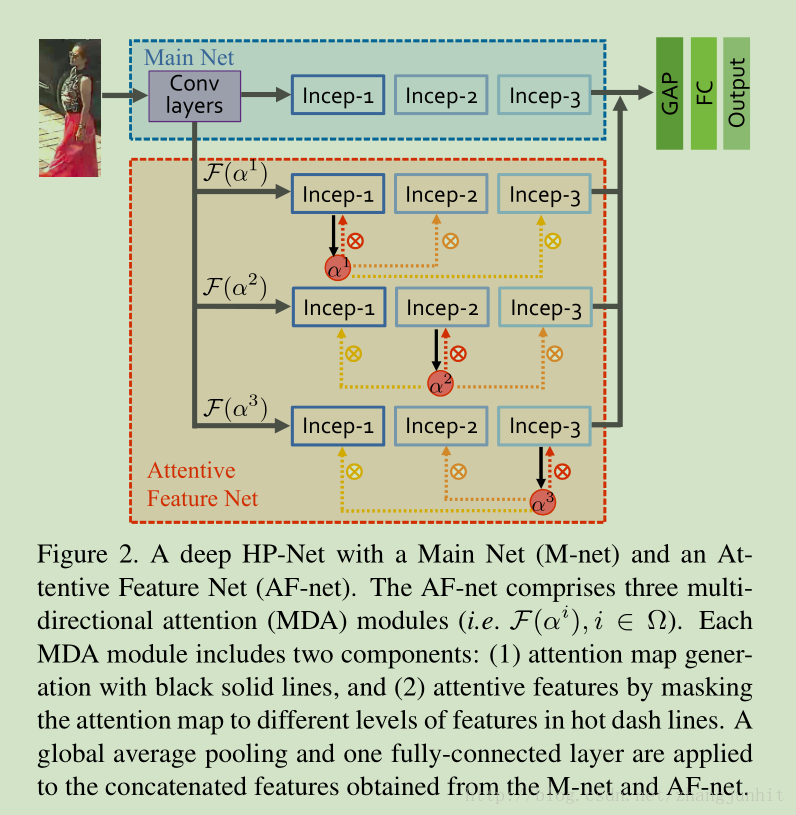(摘自王逍同学的论文arxiv-2019+Pedestrian Attribute Recognition A Survey)
1. 数据集
Dataset
Pedestrians
Attribute
Source
19000
61 binary and 4 multi-class attributes
outdoor & indoor
41585
69 binary and 3 multi-class attributes
indoor
84928
69 binary and 3 multi-class attributes
indoor
10w
26 binary attributes
outdoor
13789
14 binary attributes
WIDER images
32668
26 binary and 1 multi-class attributes
outdoor
34183
23 binary attributes
outdoor
27000
8 binary and 2 multi-class orientation attributes
outdoor
APiS
3661
11 binary and 2 multi-class attributes
KITTI , CBCL Street Scenes,INRIA and SVS
9344
27 binary attributes
image site Flickr
27454
1 binary attributes and 13 multi-class attributes
outdoor
1856
23 binary attributes and 3 multi-class attributes
Sartorialist and Flickr
Berkeley-Attributes of People dataset
8035
9 binary attributes
H3D dataset PASCAL VOC 2010
备注: 加粗的数据集是已经获取到的,RAP和RAP2.0数据集需要联系作者,之后会拿到.
2. 实现方法总结及已有资源
Github资源(图中橙色框标注):
- PANDA (CVOR-2014): <局部>
- HydraPlus-Net (ICCV-2017):<注意力>
- WPAL-network (BMVC-2014)<改进损失函数>
3.详细介绍
3.1 基于全局特征的属性检测方法
###3.1.1 FT-CNN(Re-id Using CNN Features Learned from Combination of Attributes(ICPR2016)) 在Alexnet的4096维特征上,用多个全连接分类器表征各个特征。很明显惨不忍睹。
3.2 基于局部特征的行人属性检测方法
3.2.1 Poselets (ICCV-2011)
3.2.2 PANDA(CVPR-2014)
其中关键poselet采用3.2.1《Describing people: A poselet-based approach to attribute classification》中的划分方法。通过融合局部特征和整体特征,提高了准确率。
3.2.3 MLCNN (ICB-2015)
采用网格划分,部分融合
3.2.4 ARAP (BMVC2016)
自适应检测关键点和对应Bbox,然后进行属性检测。端到端。
3.2.5 PGDM (ICME-2018)
3.2.6 LGNet (BMVC-2018)
3.2.7 总结
算法结合了全局和细粒度部件的特征,其中身体部位的定位是通过分割算法得到,如:part detection, pose estimation, poselets or proposal generation algorithm. 算法整体准确率和部件分割的算法有很大关系。
3.3 基于注意力机制的属性检测方法
3.3.1 HydraPlus-Net (ICCV-2017)
SenseTime的论文,将多层注意力机制图多向映射到不同的特征层。。HP-net包含两部分,M-Net和AF-Net。
- Main Net(M-Net): 单纯的CNN结构,论文的实现是基于inception_v2,包含三个inception block,还包含几个低层卷积层;
- Attentive Feature Net(AF-Net):三个分支,每个分支有三个inception_v2 block和一个MDA
 AF-Net包含三个子网络分支,并使用MDA模块增强,即F(αi)F(αi),其中αiαi是由inception块输出特征生成的注意力图,图中使用黑实线标记。随后应用到kth块的输出,图中用虚红线标示。每个MDA模块,有一条注意力生成链接,三条注意力特征构造链接。不同的MDA模块,注意力图由不同的inception模块生成,之后乘到不同层的特征图,生成不同层在注意特征。 MDA模块的一个示例如下图所示:
AF-Net包含三个子网络分支,并使用MDA模块增强,即F(αi)F(αi),其中αiαi是由inception块输出特征生成的注意力图,图中使用黑实线标记。随后应用到kth块的输出,图中用虚红线标示。每个MDA模块,有一条注意力生成链接,三条注意力特征构造链接。不同的MDA模块,注意力图由不同的inception模块生成,之后乘到不同层的特征图,生成不同层在注意特征。 MDA模块的一个示例如下图所示: 以下是可视化特征:
3.3.2 DIAA (ECCV-2018)
3.4 继续序列预测的属性检测方法
3.4.1 JRL (ICCV-2017)
3.4.2 RCRA (AAAI-2019)
##3.5 基于图的属性检测方法 ###h3.5.1 VSGR (AAAI-2019)












